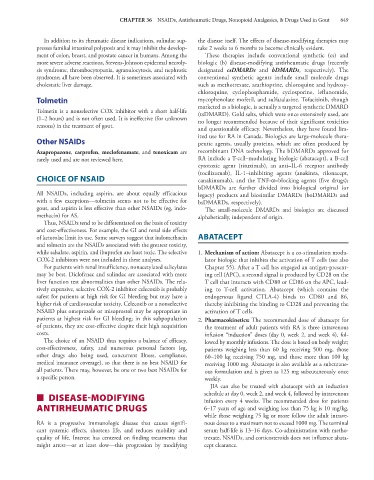Page 663 - Basic _ Clinical Pharmacology ( PDFDrive )
P. 663
CHAPTER 36 NSAIDs, Antirheumatic Drugs, Nonopioid Analgesics, & Drugs Used in Gout 649
In addition to its rheumatic disease indications, sulindac sup- the disease itself. The effects of disease-modifying therapies may
presses familial intestinal polyposis and it may inhibit the develop- take 2 weeks to 6 months to become clinically evident.
ment of colon, breast, and prostate cancer in humans. Among the These therapies include conventional synthetic (cs) and
more severe adverse reactions, Stevens-Johnson epidermal necroly- biologic (b) disease-modifying antirheumatic drugs (recently
sis syndrome, thrombocytopenia, agranulocytosis, and nephrotic designated csDMARDs and bDMARDs, respectively). The
syndrome; all have been observed. It is sometimes associated with conventional synthetic agents include small molecule drugs
cholestatic liver damage. such as methotrexate, azathioprine, chloroquine and hydroxy-
chloroquine, cyclophosphamide, cyclosporine, leflunomide,
Tolmetin mycophenolate mofetil, and sulfasalazine. Tofacitinib, though
marketed as a biologic, is actually a targeted synthetic DMARD
Tolmetin is a nonselective COX inhibitor with a short half-life (tsDMARD). Gold salts, which were once extensively used, are
(1–2 hours) and is not often used. It is ineffective (for unknown no longer recommended because of their significant toxicities
reasons) in the treatment of gout.
and questionable efficacy. Nevertheless, they have found lim-
ited use for RA in Canada. Biologics are large-molecule thera-
Other NSAIDs peutic agents, usually proteins, which are often produced by
Azapropazone, carprofen, meclofenamate, and tenoxicam are recombinant DNA technology. The bDMARDs approved for
rarely used and are not reviewed here. RA include a T-cell–modulating biologic (abatacept), a B-cell
cytotoxic agent (rituximab), an anti–IL-6 receptor antibody
(tocilizumab), IL-1–inhibiting agents (anakinra, rilonacept,
CHOICE OF NSAID canakinumab), and the TNF-α–blocking agents (five drugs);
bDMARDs are further divided into biological original (or
All NSAIDs, including aspirin, are about equally efficacious legacy) products and biosimilar DMARDs (boDMARDs and
with a few exceptions—tolmetin seems not to be effective for bsDMARDs, respectively).
gout, and aspirin is less effective than other NSAIDs (eg, indo- The small-molecule DMARDs and biologics are discussed
methacin) for AS. alphabetically, independent of origin.
Thus, NSAIDs tend to be differentiated on the basis of toxicity
and cost-effectiveness. For example, the GI and renal side effects
of ketorolac limit its use. Some surveys suggest that indomethacin ABATACEPT
and tolmetin are the NSAIDs associated with the greatest toxicity,
while salsalate, aspirin, and ibuprofen are least toxic. The selective 1. Mechanism of action: Abatacept is a co-stimulation modu-
COX-2 inhibitors were not included in these analyses. lator biologic that inhibits the activation of T cells (see also
For patients with renal insufficiency, nonacetylated salicylates Chapter 55). After a T cell has engaged an antigen-present-
may be best. Diclofenac and sulindac are associated with more ing cell (APC), a second signal is produced by CD28 on the
liver function test abnormalities than other NSAIDs. The rela- T cell that interacts with CD80 or CD86 on the APC, lead-
tively expensive, selective COX-2 inhibitor celecoxib is probably ing to T-cell activation. Abatacept (which contains the
safest for patients at high risk for GI bleeding but may have a endogenous ligand CTLA-4) binds to CD80 and 86,
higher risk of cardiovascular toxicity. Celecoxib or a nonselective thereby inhibiting the binding to CD28 and preventing the
NSAID plus omeprazole or misoprostol may be appropriate in activation of T cells.
patients at highest risk for GI bleeding; in this subpopulation 2. Pharmacokinetics: The recommended dose of abatacept for
of patients, they are cost-effective despite their high acquisition the treatment of adult patients with RA is three intravenous
costs. infusion “induction” doses (day 0, week 2, and week 4), fol-
The choice of an NSAID thus requires a balance of efficacy, lowed by monthly infusions. The dose is based on body weight;
cost-effectiveness, safety, and numerous personal factors (eg, patients weighing less than 60 kg receiving 500 mg, those
other drugs also being used, concurrent illness, compliance, 60–100 kg receiving 750 mg, and those more than 100 kg
medical insurance coverage), so that there is no best NSAID for receiving 1000 mg. Abatacept is also available as a subcutane-
all patients. There may, however, be one or two best NSAIDs for ous formulation and is given as 125 mg subcutaneously once
a specific person. weekly.
JIA can also be treated with abatacept with an induction
■ DISEASE-MODIFYING schedule at day 0, week 2, and week 4, followed by intravenous
infusion every 4 weeks. The recommended dose for patients
ANTIRHEUMATIC DRUGS 6–17 years of age and weighing less than 75 kg is 10 mg/kg,
while those weighing 75 kg or more follow the adult intrave-
RA is a progressive immunologic disease that causes signifi- nous doses to a maximum not to exceed 1000 mg. The terminal
cant systemic effects, shortens life, and reduces mobility and serum half-life is 13–16 days. Co-administration with metho-
quality of life. Interest has centered on finding treatments that trexate, NSAIDs, and corticosteroids does not influence abata-
might arrest—or at least slow—this progression by modifying cept clearance.

